
Sleepy Hollow is a village in the town of Mount Pleasant, in Westchester County, New York, United States. The village is located on the east bank of the Hudson River, about 30 miles (48 km) north of New York City, and is served by the Philipse Manor stop on the Metro-North Hudson Line. To the south of Sleepy Hollow is the village of Tarrytown, and to the north and east are unincorporated parts of Mount Pleasant. The population of the village at the 2020 census was 9,986.
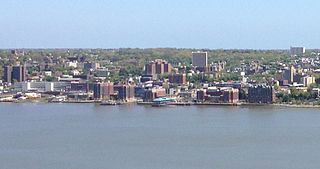
Yonkers is a city in Westchester County, New York, and a suburb of New York City. Developed along the Hudson River, it is the third most populous city in the state of New York, after New York City and Buffalo. The population of Yonkers was 211,569 as enumerated in the 2020 United States Census. It is classified as an inner suburb of New York City, located directly to the north of the Bronx and approximately 2.4 miles (4 km) north of Marble Hill, Manhattan, the northernmost point in Manhattan.
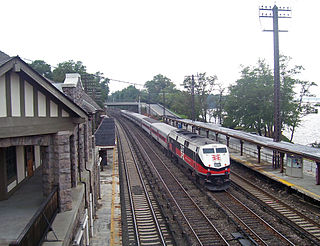
Philipse Manor station is a commuter rail stop on the Metro-North Railroad's Hudson Line, located in the Philipse Manor area of Sleepy Hollow, New York, United States.

Philipsburg Manor House is a historic house in the Upper Mills section of the former sprawling Colonial-era estate known as Philipsburg Manor. Together with a water mill and trading site the house is operated as a non-profit museum by Historic Hudson Valley. It is located on US 9 in the village of Sleepy Hollow, New York.
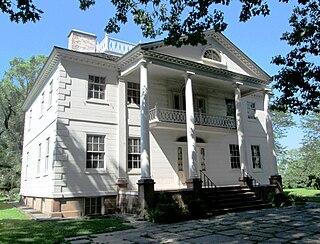
The Morris–Jumel Mansion or Morris House is an 18th-century Federal style museum home in upper Manhattan, New York City. It was built in 1765 by Roger Morris, a British military officer, and served as a headquarters for both sides in the American Revolution.
Philipse Manor may refer to:

The Saw Mill River is a 23.5-mile (37.8 km) tributary of the Hudson River in Westchester County, New York, United States. It flows from an unnamed pond north of Chappaqua to Getty Square in Yonkers, where it empties into the Hudson as that river's southernmost tributary. It is the only major stream in southern Westchester County to drain into the Hudson instead of Long Island Sound. It drains an area of 26.5 square miles (69 km2), most of it heavily developed suburbia. For 16 miles (26 km), it flows parallel to the Saw Mill River Parkway, a commuter artery, an association that has been said to give the river an "identity crisis."

The Old Dutch Church of Sleepy Hollow (Dutch: Oude Nederlandse Kerk van Sleepy Hollow), listed on the National Register of Historic Places as Dutch Reformed Church (Sleepy Hollow), is a 17th-century stone church located on Albany Post Road (U.S. Route 9) in Sleepy Hollow, New York, United States. It and its three-acre (1.2 ha) churchyard feature prominently in Washington Irving's 1820 short story "The Legend of Sleepy Hollow". The churchyard is often confused with the contiguous but separate Sleepy Hollow Cemetery.
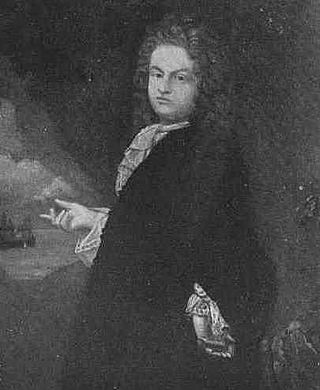
Frederick Philipse, first Lord of the Manor of Philipseborough (Philipsburg) and patriarch of the Philipse family, was a Dutch immigrant to North America of Bohemian heritage. A merchant, he arrived in America as early as 1653. In 1662, he married Margaret Hardenbrook de Vries, a wealthy and driven widow. Together, and variously in league with slavers, pirates, and other undesirables, the couple amassed a fortune.
Jacobus van Cortlandt (1658–1739) was a wealthy Dutch-born American merchant, slave owner, and politician who served as the 30th and 33rd Mayor of New York City from 1710 to 1711 and again from 1719 to 1720.
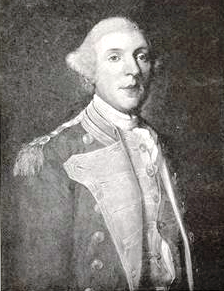
Roger Morris was a colonel in the British Army who fought in the French and Indian War. He was married to Mary Philipse, middle daughter of Frederick Philipse, second Lord of the Philipsburg Manor, and a possible love interest of George Washington. She owned a one-third share of the Philipse Patent, a vast landed estate on the Hudson River which later became Putnam County, New York.

Philipsburg Manor was a manor located north of New York City in Westchester County in the Province of New York. Netherlands-born Frederick Philipse I and two partners made the initial purchase of land that had been part of a Dutch patroonship owned by Adriaen van der Donck. Philipse subsequently bought his partners out and added more land before being granted a royal charter in 1693 for the 52,000 acres (21,000 ha) estate, becoming its first lord.
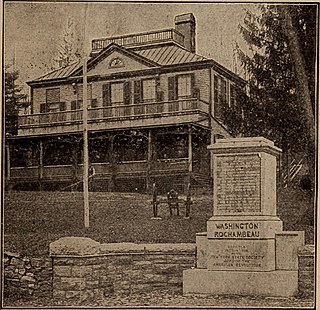
Hyatt-Livingston House was an historic home located at Dobbs Ferry, Westchester County, New York, at the corner of Colonial Avenue and Broadway. Originally constructed as part of the Philipsburg Manor around 1690 by land baron Frederick Philipse, the house was at first a smaller tenant-farmer's dwelling home to the John Hyatt family. In 1705, Hyatt's daughter Elizabeth married neighbor John Dobbs, who originally brought that family name to the area and perhaps started the ferry for which the village is named. In the early 18th century, the house was enlarged to a five-bay, 2+1⁄2-story dwelling that then formed the central part of the house. It was of wood-frame construction, with a gable roof, and sat on a fieldstone foundation.

The Pocantico River is a nine-mile-long (14 km) tributary of the Hudson River in western central Westchester County, New York, United States. It rises from Echo Lake, in the town of New Castle south of the hamlet of Millwood, and flows generally southwest past Briarcliff Manor to its outlet at Sleepy Hollow. Portions of the towns of Mount Pleasant and Ossining are within its 16-square-mile (41 km2) watershed.
There are numerous nationally and locally designated historic sites and attractions in Westchester County. These include architecturally significant manors and estates, churches, cemeteries, farmhouses, African-American heritage sites, and underground railroad depots and waystations. There are sites from pre-Revolutionary and Revolutionary times, as well as battlegrounds. Westchester County also played an important role in the development of the modern suburb, and there are many associated heritage sites and museums.

Frederick Philipse II, was a colonial American merchant, landowner, and politician. Philipse was the only son of Maria Sparkes, daughter of the Governor of Barbados, and Philip Philipse, eldest son of Frederick Philipse I, 1st Lord of the Philipsburg Manor. Philip predeceased his father, and family lands passed on to younger son Adolphus Philipse. Upon his uncle's death Frederick II inherited his share of Philipse lands and commercial interests, thereafter becoming the elder Philipse male and 2nd Lord of Philipsburg Manor.

Frederick Philipse III was the third and last Lord of Philipsburg Manor, a 52,000 acres (21,000 ha) hereditary estate in lower Westchester County, New York, and a Loyalist during the Revolutionary War.

Philip Philipse (1663–1699) was the eldest son and heir of Frederick Philipse, a Dutch-born merchant trader, slaver, land baron, and 1st Lord of Philipsburg Manor. However, he died before his father, and by Frederick's will Philip's legacy was split between his bachelor brother Adolphus Philipse and his son Frederick Philipse II, who became the 2nd Lord of Philipse Manor.

Mary "Polly" Philipse (1730–1825) was the middle daughter of Frederick Philipse II, 2nd Lord of Philipsburg Manor of Westchester County, New York. Of Anglo-Dutch extraction, she was a wealthy heiress, possible early love interest of George Washington, and New York City socialite. Married to an ex-British army colonel, her Loyalist sympathies in the American Revolution reshaped her life.

The African American Heritage Trail of Westchester County in New York was created in 2004 to help preserve and interpret the historic landmark places that help tell the narratives of women and men of African descent who have made significant contributions to an American identity. The initial list had 13 sites. Westchester County historian and Schulman History Honoree Dr. Larry Spruill was lead consultant and researcher for the project.





















